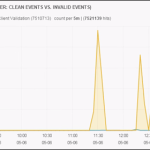 In 2012, Anonymous introduced HOIC (high orbit ion cannon) as a replacement to LOIC (low orbit ion cannon). Unlike its predecessors, that were built upon C#, and later java. This new DDoS player was built upon the unsuspecting language of Visual Basic. Taught in high school classrooms, Visual Basic was largely seen by the programming community as a means for kids and young programmers to get their feet wet in the experience of programming. Considered by many programmers as grossly inefficient and a memory hog; Visual Basic was an unsuspected carrier for what would become one of the most powerful means of DDoS. One of the popular notions of HOIC has been its ability to randomize variables such as: user agent, referrer and URI, during an attack. In the same manner, an attack tool known as HULK (developed by: Barry Shteiman, 2012), written in Python, was developed in recent history. Within a controlled environment we tested these DDoS tools to judge their effectiveness and total output. In controlled trials the DDoS output of LOIC (Visual Basic on Windows) outperforms the DDoS output HULK (Python on Linux) by +40%. Figure 1: HOIC Test in Stable Windows Environment Figure 2: HULK Test While many of us in the Internet security industry ridicule and downplay the “kiddie hacker;” it is clear that it sometimes only takes a kiddie to build an empire. Lessons in open source economics teach us that in an open access environment, it takes only a small few to bring about radical change and innovation. Today HOIC has become one of the primary tools of groups such as anonymous. From this lesson, we can expect that challenges and sudden changes, will not come from those paid hundreds of thousands a year; but from those small few kiddies, whom are politically motivated and are paid nothing. Source: http://www.dosarrest.com/ddos-blog/how-visual-basic-broke-modern-python-welcome-to-the-world-of-high-orbit-ion-cannon/
In 2012, Anonymous introduced HOIC (high orbit ion cannon) as a replacement to LOIC (low orbit ion cannon). Unlike its predecessors, that were built upon C#, and later java. This new DDoS player was built upon the unsuspecting language of Visual Basic. Taught in high school classrooms, Visual Basic was largely seen by the programming community as a means for kids and young programmers to get their feet wet in the experience of programming. Considered by many programmers as grossly inefficient and a memory hog; Visual Basic was an unsuspected carrier for what would become one of the most powerful means of DDoS. One of the popular notions of HOIC has been its ability to randomize variables such as: user agent, referrer and URI, during an attack. In the same manner, an attack tool known as HULK (developed by: Barry Shteiman, 2012), written in Python, was developed in recent history. Within a controlled environment we tested these DDoS tools to judge their effectiveness and total output. In controlled trials the DDoS output of LOIC (Visual Basic on Windows) outperforms the DDoS output HULK (Python on Linux) by +40%. Figure 1: HOIC Test in Stable Windows Environment Figure 2: HULK Test While many of us in the Internet security industry ridicule and downplay the “kiddie hacker;” it is clear that it sometimes only takes a kiddie to build an empire. Lessons in open source economics teach us that in an open access environment, it takes only a small few to bring about radical change and innovation. Today HOIC has become one of the primary tools of groups such as anonymous. From this lesson, we can expect that challenges and sudden changes, will not come from those paid hundreds of thousands a year; but from those small few kiddies, whom are politically motivated and are paid nothing. Source: http://www.dosarrest.com/ddos-blog/how-visual-basic-broke-modern-python-welcome-to-the-world-of-high-orbit-ion-cannon/
Continued here:
How Visual Basic Broke Modern Python: Welcome to the World of High Orbit Ion Cannon

